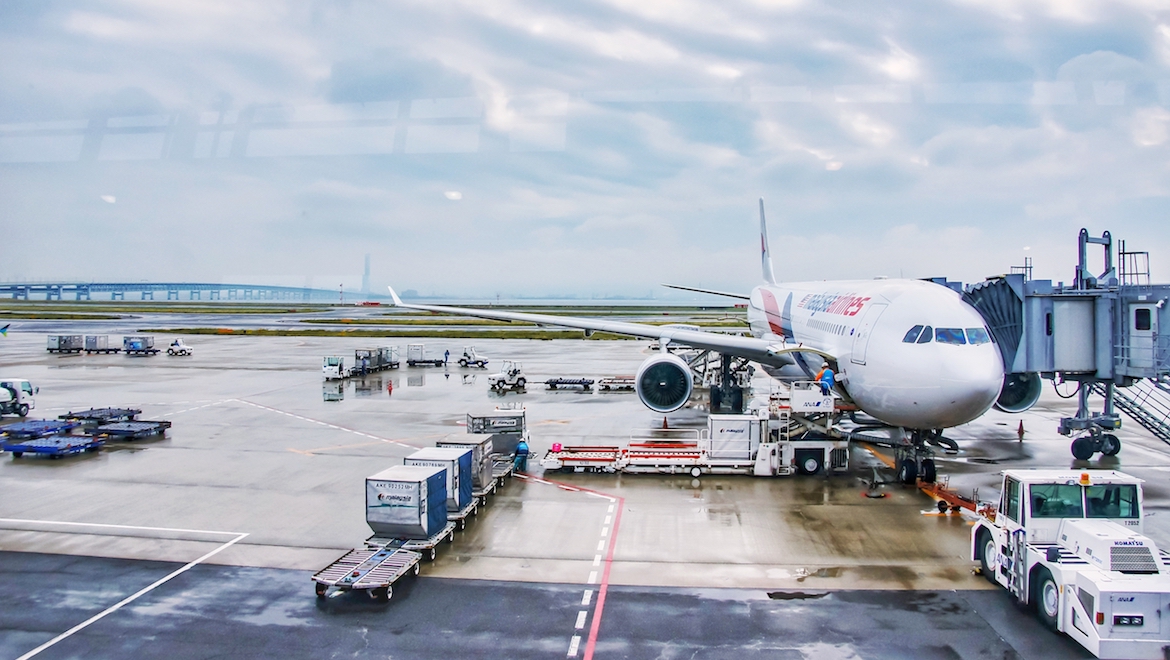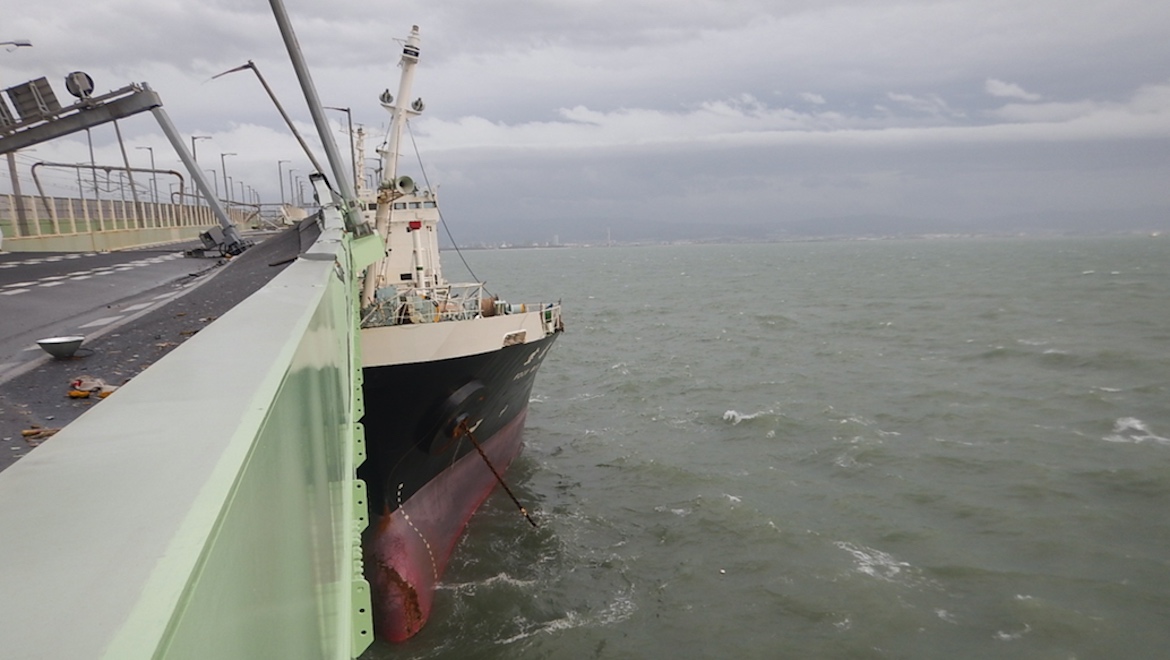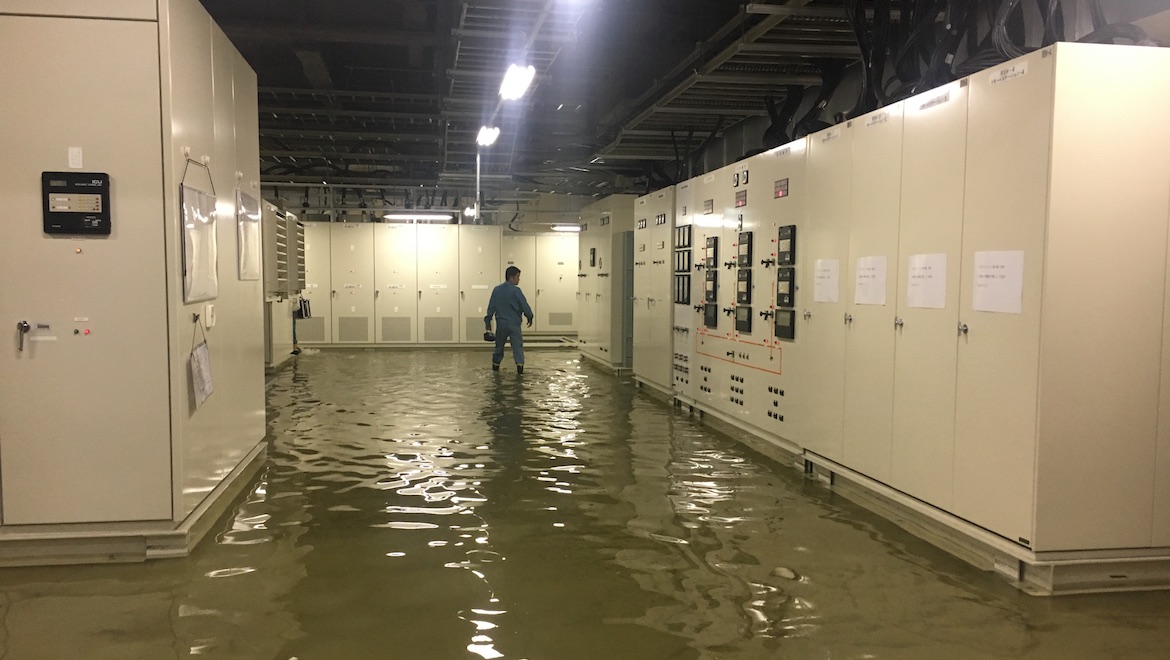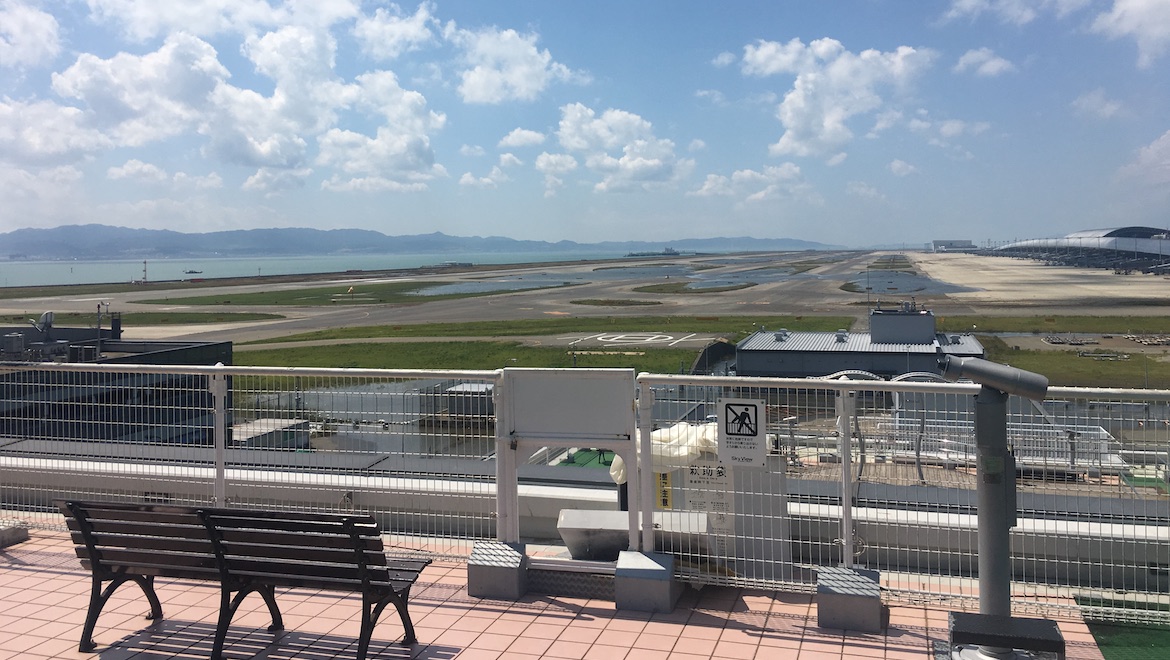This story about how Osaka Kansai Airport recovered from the devastating impact of Typhoon Jebi by John Walton first appeared in the January-February 2019 edition of Australian Aviation.

When September’s Typhoon Jebi slammed into Kansai Airport in Osaka Bay with winds of over 200km/h, the realities of climate change hit home as hard as the 2,591-tonne fuel tanker Houn Maru, which broke free from its moorings and collided with the single 3km bridge to the island airport, severing links to the mainland and stranding thousands of passengers who were sheltering in the airport and thousands more staff at work.
Power cuts from inundated sea-level electricity facilities and the loss of flooded emergency facilities left the refugees quite literally in the dark.
Kansai Airport’s two linked artificial islands are an engineering marvel, selected as a Monument of the Millennium by the American Society of Civil Engineers in 2001 alongside the Panama Canal, Hoover Dam and Empire State Building.
The airport itself has seen skyrocketing growth over recent years, in long-haul and short-haul, in passenger and cargo demand, in low-cost carriers and in full-service airlines. Its profitability turnaround after being privatised and run by a Franco-Japanese consortium has spurred further privatisation initiatives across Japan.
But questions arose as quickly as the typhoon sped overhead: why was a single point of failure unprotected from a ship impact? Why were so many key emergency features flooded in the basement of the island? What needs to be done to stop it from happening again? And how resilient are the large number of seaside airports around the world?

Kansai Airport vital to the region
Built in 1994, Kansai (IATA code KIX) is Japan’s third busiest airport after the two serving Tokyo. It was constructed offshore in relatively shallow waters, around an hour south of Osaka’s city centre, and largely replaced Itami Airport (ITM) to the north of the city.
As such, it serves Japan’s second most populated region.
A rough Australian equivalent would be a larger Essendon as a domestic-only airport for Melbourne, with Tullamarine built on a four-kilometre artificial island off Frankston.
The offshore airport on artificial islands is a Japanese signature solution. Its selection came after long, violent and deadly protests over the process used to procure land for Narita International Airport in Chiba Prefecture to the east of Tokyo, as well as noise complaints and operational issues with the 11pm-6am curfew.
With 24-hour operations, Kansai Airport now serves about 29 million passengers via two runways, the original 3,500m runway that is now 06R/24L on the first artificial island and the second runway, the 4,000m 06L/24R, built on the second island which opened in 2007.
The first island contains the Renzo Piano-designed Terminal 1, plus the majority of the landside infrastructure: train termini for both the West Japan Railway Company (known as JR West) and the Nankai Railway (the competing private operator), multiple hotels and retail outlets, cargo warehousing, and other spaces.
The sole link to the airport, the rail and road links over Sky Gate Bridge R, the largest double-decked truss bridge in the world, connects the first island to Rinku Town (a double-transliteration of “Link Town”), a cluster of hotels, outlets and tourist facilities just across the bridge from the airport in the city of Izumisano.

Kansai Airport is jointly operated by French infrastructure giant Vinci and Japanese conglomerate Orix, and later also assumed responsibility for the smaller island airport serving Kobe across the bay. KIX is approaching 1,400 scheduled flights a week of which about 10 per cent are freight.
FedEx, which established its north Pacific regional hub at KIX in 2014, operates more than 50 of the weekly cargo flights, while UPS operates 16, China Airlines 13 and ANA Cargo 10, among a wide variety of other largely Asian and European cargo airlines.
Low-cost carriers are also a focus for Kansai, thanks to room for infrastructure growth and the 24-hour operations. Most operate from the original terminal 1, with ANA group member Peach, Korean Jeju Air and Chinese Spring Airlines using the more bare-bones terminal 2 on the second island. Peach operates the largest number of weekly flights, 80, while numerous other LCCs based across Asia have a strong presence.
China Eastern is in the number two slot with 60 weekly flights, followed in the 50-60 weekly flights category by JAL, Korean Air, Jeju Air, T’way Airlines and China Airlines. Around 40-50 flights a week are operated by ANA, Asiana, Jin Air, Air China, China Southern and Cathay Pacific. Qantas currently operates three weekly flights and Jetstar long-haul five.
Kansai as a region is accustomed to natural disasters: the 1995 Kobe earthquake’s epicentre was about 20km away, while typhoons regularly sweep across the area. But when the strongest typhoon in 25 years struck the airport on September 4, with a 3.3m storm surge and winds approaching the takeoff speed of a commercial jet, it caused significant damage.

Flooding cut operations, but a ship cut off the airport
Kansai Airport is sinking. Settlement of the first island since construction reached 3.43m in 2017, a rate that has stabilised at six to seven centimetres a year over the past decade. Settlement was always expected, although much of the island is now less than three metres above sea level and work to raise its seawalls is ongoing.
Typhoon Jebi caused three major kinds of damage to the airport: winds tore roofs and shutters away from the cargo warehouse precinct, a storm surge above the level of the first island flooded electrical facilities and the emergency centre. But the most substantial – and certainly most dramatic – damage came from one of the fuel ships serving the airport.
On the first island, impacts were severe. The runway and almost all the tarmac area were flooded and inside terminal 1 floodwater took out power, electrical equipment, airconditioning, passenger and cargo handling facilities – and the airport’s disaster prevention facilities which were located underground. Subterranean rail and surface road access routes were flooded, while the fuel ship crashing into the bridge also created a gas leak from a utility conduit from the mainland.
In the landside Aeroplaza development, home to the airport’s hotels and location of much of its emergency shelter capacity, some glass in the lobby on level two was broken and a passenger injured an arm. Yet despite a lack of power, airconditioning and light in some spaces, injuries were remarkably light among the thousands of passengers sheltering on the airport island.
Speaking to media including Australian Aviation at a briefing day, representative director and co-chief executive officer Emmanuel Menanteau described the cargo operations as having seen “severe impact and severe damage”, with warehouses belonging to the airport and to third parties highly impacted. The cargo area on the first island, Menanteau said, was directly hit by wind and waves, taking substantial time to recover.
Yet the prognosis even in the short-term was positive and cargo operations were “back on track” by October 3, a month after the typhoon, with traffic “back to normal”.
Menanteau said the airport had established an internal task force, supported by a national expert third party committee looking at resilience at all major Japanese airports, to examine action needed to prevent and mitigate impact from future disasters. Specific topics relevant to Kansai include protection of the islands through their seawalls, building resistance, and disaster resilience.
Immediate criticism in the aftermath of the typhoon of a sinking island airport putting its disaster facilities underground seemed warranted. Plans are underway to secure additional, more resilient space, although there are competitive tensions on the nature and location of this facility.


Images of a ship hitting the bridge flashed worldwide
The Houn Maru, the fuel tanker which serves the airport’s fuel farms, owned by Hinode Shipping Company of Fukuoka, was anchored approximately two kilometres southeast of the airport during the morning of September 4, according to airport statements to Australian Aviation and local reports. Winds of up to 216km/h pushed the vessel into the Sky Gate Bridge R at approximately 2pm on September 4.
According to the airport’s chief technology officer Benoit Rulleau, the bridge, which is not part of the concession managed by the airport company, appeared to have had no particular protection against ship contact.
“The ship was stationed in Osaka Bay between the airport and the Rinku Town area [the nearest point on the mainland]. The ship was dragged away from its anchor point by the wind. What we can do to avoid this happening again is, of course, when there is a typhoon forecast, to avoid that any ship will be stationed in this area.”
It is unclear, and indeed the subject of investigation, why the vessel was not anchored further from the airport given that the Japan Coast Guard issued its standard recommendation that ships keep a distance of 5.5km away from the airport during severe weather. Airport executives declined to be drawn on whether they were pressing for additional measures to be taken to prevent shipping collisions with the bridge and to defend against them in the event they happen.
The bridge supports three main decks: the inbound two-lane road to the airport on the higher southern platform, the railway tracks on the lower central platform, and the outbound two-lane road from the airport on the higher northern platform. Each road platform also has a third lane-capable shoulder and the ability to be turned into a single lane in/out roadway.
The Houn Maru struck the southern road platform directly, pushing several sections three metres to the north to strike the railway platform, which moved 50cm northwards. Support structures for the platforms, designed to withstand earthquakes and tsunami, were also moved as a result of the platform movement.
The combined airport and railway authorities swiftly realised that the inbound road had suffered major damage and would require replacement of the bridge, while the outbound road was largely unscathed. However, the railway platform was largely in a repairable state, explained Tsuyoshi Tabuchi, senior manager in the West Japan Railway Company’s Kansai Urban Regional Head Office, and the company sprung into action.
VIDEO: A look at the tanker smashing into the bridge from the Airline net YouTube channel.
Railway bridge repairs took just four days
Kansai Airport is served by two rail companies using a shared underground station next to terminal 1, and the railway infrastructure is primarily managed by the privatised legacy national service provider, usually known as JR West, which serves the main island of Honshu in Osaka, the Kansai region, and points west as far as Fukuoka on the island of Kyushu.
JR West operates both a “limited express” airport express service, the Haruka, as well as regular all-stops or most-stops commuter trains into Osaka. The private Nankai Railway, a largely Osaka commuter operation, also runs trains into a different set of Osaka stations.
Immediately after the storm passed, JR West started a detailed assessment, said Tabushi, categorising assets as either “reusable” or “need to replace”. The planning process determined the ways to reinforce existing reusable structures and estimated transport times. Matters were further complicated for JR West by the fact that sections of the southern inbound motorway bridge were resting on the railway bridge.
Initially, JR West’s assumptions were that resuming service would take at least one month. Engineers arrived to carry out preparatory works, starting with pumping out water from the four metre-deep, one kilometre-long subterranean approach section of the track to the underground airport station, and removing debris from the heavily flooded tracks. Damaged supports were removed, major equipment including cranes and support beam jacking equipment were positioned, and full safety and preparation assessments were made.
This preparation time reaped rewards for JR West – and for the airport. The motorway sections were removed by road operator Nexco by the afternoon of Friday September 14, with damaged track removal complete by the end of the same day.
The support beams were moved overnight and into the following day, with track repair and electric catenary installations completed in just two days when test running began. Testing and checks lasted through the Monday (September 17) with operations restored on the Tuesday, just two weeks after the typhoon and fewer than four days after the motorway was moved.

Despite the loss of its emergency centre, the airport coped well
Evacuation of passengers sheltering at the airport began the day after the typhoon. Including employees, about 8,000 people needed to be moved and a fleet of 25 buses completed their initial transportation by midnight.
While some passengers complained of a lack of communication, on balance, the response was well-organised.
Airport operations resumed on September 7, the third day following the typhoon. Making the most of the higher position and relative lack of flooding of the second island, where the low-cost carrier terminal 2 is located, flights reopened using the longer northern runway, 06L/24R.
Peach, the primary carrier at the terminal, operated flights both on its own account and for parent airline ANA whose normal facilities on the first island and in terminal 1 remained disrupted.
Access for passengers at that early stage was limited to a fleet of shuttle buses from the mainland, and remained limited through the opening of the first island’s southern runway (06R/24L) and the southern wing of terminal 1 on September 14. The cargo warehousing facilities also resumed operations on that day.
Assistance from other Japanese airports with machinery and materiel had arrived swiftly, with both Nagoya’s Central Japan (Chubu Centrair) International Airport and Narita International Airport contributing.
With the reopening of rail services on September 18, and restoration of the northern wing of the terminal on September 21, the airport had returned to a mostly normal state of affairs within three weeks. Completion of all repairs (largely involving the southern span of the motorway bridge) is expected in time for Golden Week, the height of the Japanese travel season at the end of April in 2019.
Passenger and cargo numbers quickly rebounded, with little sign of any effect on traffic from Kansai’s key Asian markets. It could be that passengers from these markets are well used to the impact of typhoons and that signs of a flooded airport failed to dampen their enthusiasm for travel.
Nevertheless, the Japan Tourism Agency launched its Inbound Tourism Revival Plan, with the airport, airlines, railway companies and a wide variety of other industry players taking part.
Reduced fares, special welcome greeters in traditional dress, welcome messages on Nankai Railways’ rapid airport express, free luggage transport, Hello Kitty gifts to tie in to JR West’s Hello Kitty-liveried Shinkansen bullet train, welcome food and drinks and, of course, the inevitable yuruchara mascots, in this case the airport’s Sorayun and Nankai Railway’s Rapi:t-kun.

Study into future resilience and lessons learned
“We spent approximately 105 billion yen at the end of October,” said airport chief technology officer Benoit Rulleau in mid-November. “The total repair cost is not clear yet. We have significant damages in many different parts. We don’t even have yet a total assessment of damage. Some damage is hidden. When you have salty water touching equipment, you don’t know what’s happening inside that equipment. I cannot confirm any number for total repairs.”
The recovery process will be funded “100 per cent by the airport. We are managing the airport, we are the operator of the airport. All the repairs are on us. For this we have insurance,” Rulleau said.
The airport operator has already been “actively thinking about what we can do to improve our resilience for future typhoons, future tsunamis, future earthquakes, and all the natural disasters that we could have. We are elaborating plans to increase our resilience. We have started a first series of measures to be available for the next typhoon season. Together with NCAC and the Japanese Government we are looking at the total resilience business continuity plan, which includes both hardware measures – more protections against typhoons, against the sea, against earthquakes – and software measures: operational organisation, emergency teams, organisation between the three airports,” Rulleau said.
With the operator also running Osaka’s Itami domestic airport and Kobe’s largely domestic airport across the bay, Rulleau said there were key questions: “how can we use the three airports if we have some damage at one of the three airports; how can we best use the two other airports to compensate and accommodate the traffic, passengers and airlines that want to fly to Kansai?
“Some projects have started already, because we want them to be ready for the next typhoon season,” he said.
“Some projects will take more time. For example, raising a seawall is not done in a few months. It can take three years. The Japanese government is willing to support us, but also to support other airports in Japan.”
Rulleau said the government’s expert committee of third parties would look across all airports, at both organisation and infrastructure, to understand weaknesses in the face of natural disasters.
He said the committee would then make recommendations to the government that could result in a national policy.
In the event of a forecastable event such as a typhoon at Kansai, the consensus seems to be that sheltering passengers and staff on an island is less sensible than running evacuation shuttle trains over the railway bridge prior to the event.
Facilities and procedures are being reviewed, meanwhile, for unpredictable events such as earthquakes and tsunamis. It would seem that a relocation of both the emergency command centre and at least some of the electrical equipment would make sense.
Kansai Airport, its region and indeed Japan, has a lot to be proud of in its response to a significant natural disaster. Yet nobody is shying away from the key learnings in the aftermath, particularly around improvements to resilience.
KIX had a strong business continuity plan in place and yet unexpected problems still arose. There are lessons for every airport, airline, passenger or other player in the world of aviation.

This story first appeared in the January-February 2019 edition of Australian Aviation. To read more stories like this, subscribe here.
















Richard
says:Very informative John especially for those planning a trip to Japan during the Typhoon season.
My studies of USN operations in the Philippine and South China Seas and those around Formosa and Japan itself from the 1920’s to 1945, reveal that Typhoons were a common occurrence.
Maybe they had climate change as well then!